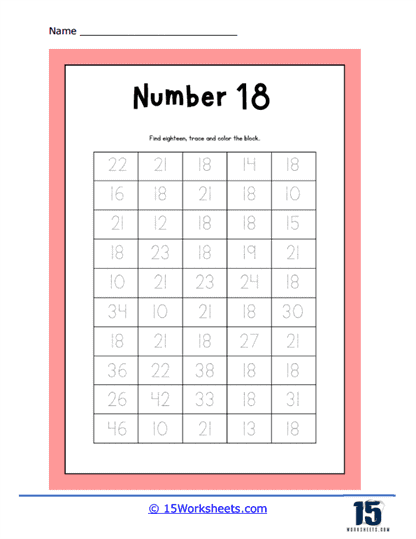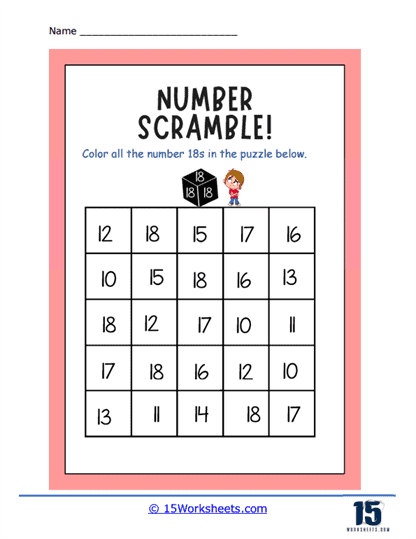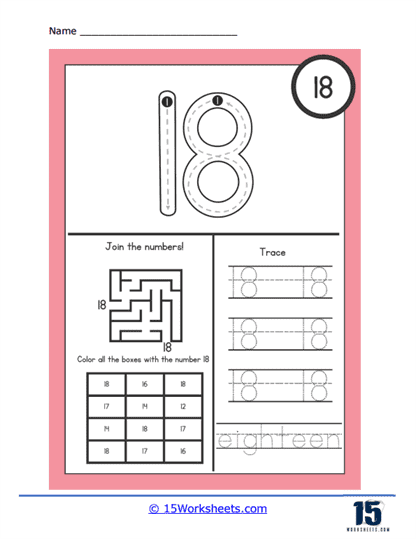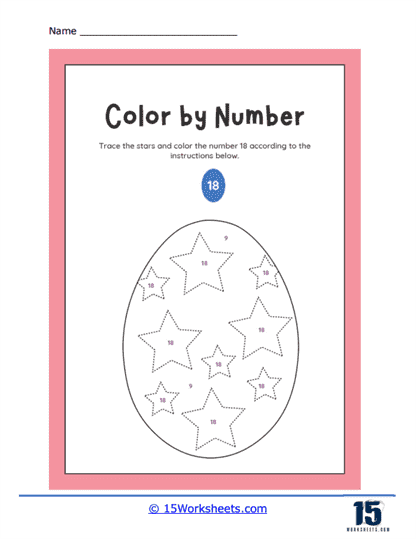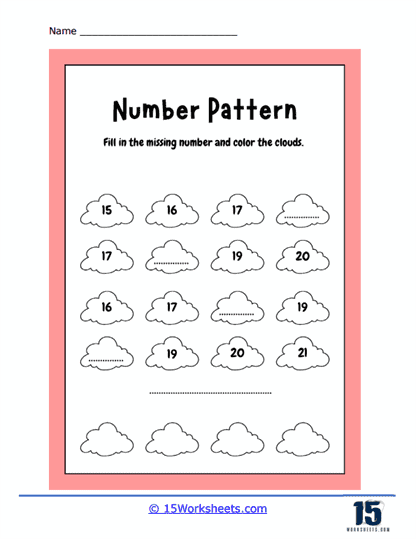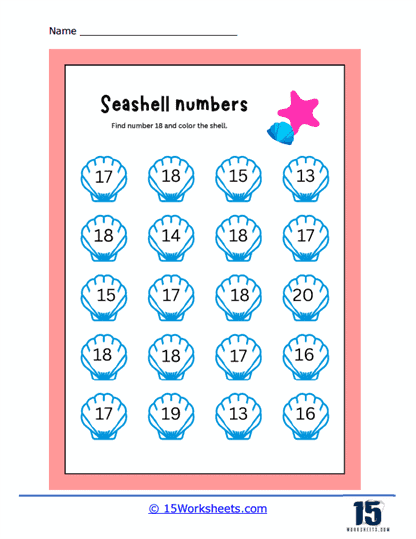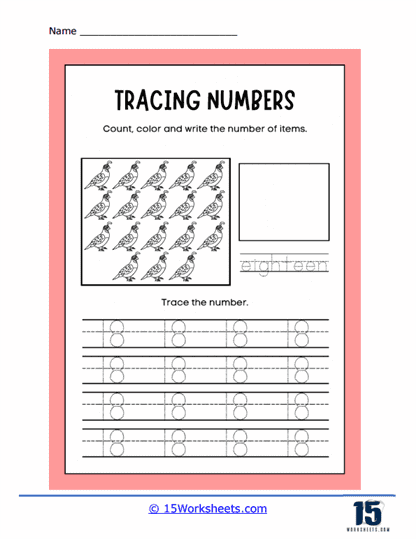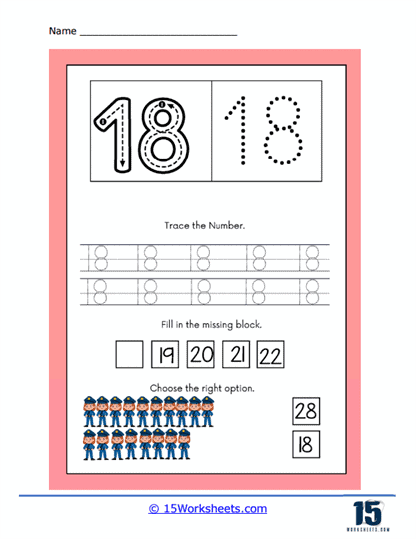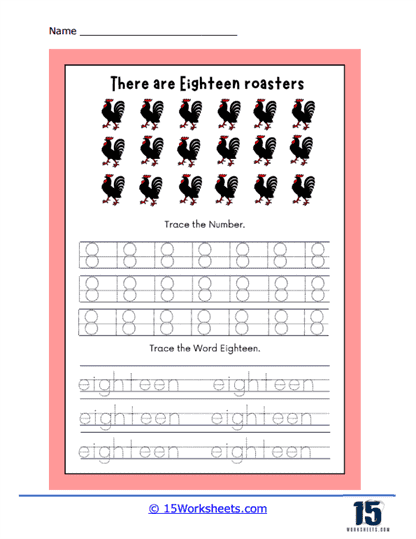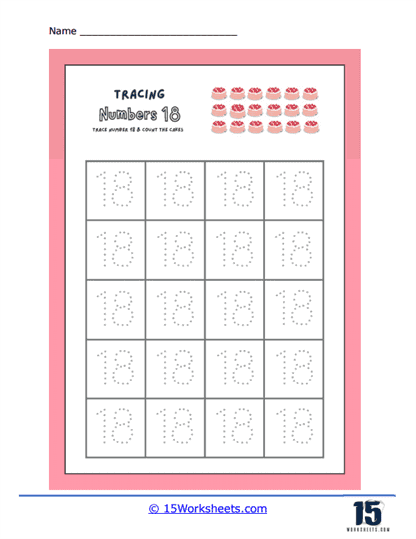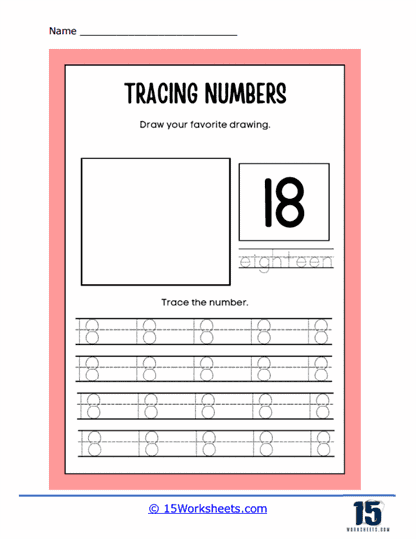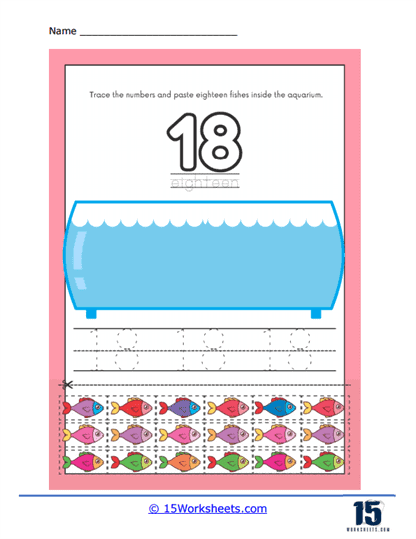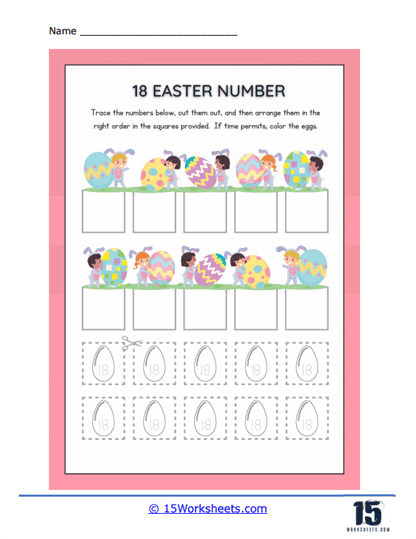Number 18 Worksheets
About These 15 Worksheets
Worksheets designed around specific numbers, such as the Number 18 Worksheets, offer a structured and methodical approach to teaching that fosters both engagement and comprehension. The structure of these worksheets is essential, especially when introducing new concepts to young learners. When teaching a number like 18, it’s not enough to simply state its value; students need a gradual, step-by-step introduction to understand the various facets of the number. Worksheets begin with foundational tasks, such as recognizing and tracing the number, helping to establish a concrete understanding of what 18 represents. From there, the activities progress, slowly introducing mathematical operations such as addition, subtraction, and eventually multiplication and division. This sequential method ensures that children don’t become overwhelmed but are instead gently guided through increasingly complex ideas. The systematic nature of these worksheets is what makes intricate mathematical concepts more manageable and approachable for young minds.
In addition to providing structure, Number 18 Worksheets help students internalize number patterns and the broader numerical system in which those patterns exist. Numbers aren’t just arbitrary symbols; they represent quantities and relationships that are fundamental to our base-10 system. When a student encounters the number 18, they need to understand it as an embodiment of ten and eight. This understanding goes beyond memorization-students begin to see the deeper connection between numbers and how they interact within the larger framework of mathematics. Worksheets that include visual aids, such as base-10 blocks or diagrams that break 18 into tens and ones, reinforce this concept. By seeing and manipulating these numbers in different forms, students gain a clearer sense of how numbers function together. This form of learning helps cement foundational math skills, making future mathematical learning more intuitive and less intimidating.
Repetition is a critical component of learning, particularly in mathematics, where mastery of a concept often comes from repeated practice. Number 18 Worksheets provide the ideal platform for this kind of reinforcement. Each time a student completes a worksheet, they are not only practicing the same skill but also strengthening the neural pathways that make recalling and applying that skill easier in the future. Unlike monotonous drills, these worksheets can be designed in an engaging way, turning repetition into a fun activity. Whether through games, puzzles, or creatively designed word problems, the repetitive practice becomes less of a chore and more of an opportunity to solve challenges. By making this practice enjoyable, worksheets encourage students to persist and explore their math skills in a deeper way, turning what could be tedious repetition into active learning.
Visual learning is another significant advantage of Number 18 Worksheets. Many students are naturally visual learners, absorbing and retaining information more effectively when it is presented in a pictorial or graphic form. These worksheets often include colorful representations, diagrams, and patterns that help students make sense of abstract numbers. For example, seeing 18 objects divided into groups of 10 and 8 can make the concept of place value come to life in a way that traditional explanations might not. The human brain is wired to process and understand visual information quickly, which is why incorporating visual elements into worksheets can enhance learning. For children who struggle with purely numerical or verbal instructions, this method provides a bridge, making math less daunting and more accessible. In turn, it fosters a deeper connection to numbers, improving both comprehension and retention.
The role of worksheets in boosting a student’s confidence cannot be overstated. The sense of achievement that comes with completing a worksheet correctly serves as powerful positive reinforcement. Each small success builds the student’s self-esteem and encourages them to tackle more difficult tasks with confidence. Over time, this positive cycle of effort and reward leads to increased motivation. When students feel that they are succeeding, they are more likely to engage with the material, ask questions, and challenge themselves. The structured, scaffolded approach of Number 18 Worksheets gives students the tools they need to succeed at each step, thereby nurturing both their skills and their belief in their abilities. This growth in confidence is crucial, as students who feel capable are more likely to develop a love for learning and a willingness to persevere through challenges.
For homeschooling parents, these Worksheets provide a valuable tool for monitoring and assessing their child’s progress. The worksheets offer a clear picture of the student’s current understanding, highlighting areas where they excel and identifying concepts that may require additional support. This immediate feedback allows parents to adjust their teaching strategies, either by providing more practice where needed or by moving forward when mastery has been achieved. This tailored approach ensures that the child is learning at a pace that suits their individual needs, maximizing the effectiveness of their education. Moreover, the tangible record of progress that worksheets provide can be reassuring for both the parent and the student, offering clear evidence of growth over time.
The Historic Significance of the Number 18
The number 18 has held significant meaning across various cultures, religions, and historical contexts. Its symbolic value is deeply rooted in numerology, religious beliefs, and even political or social frameworks, making it a number that resonates with multiple layers of meaning. Below is a detailed exploration of its significance across different fields of human experience:
1. Religious and Spiritual Significance
In Judaism, the number 18 holds profound importance because it corresponds to the Hebrew word “chai” (חַי), which means “life.” In gematria (Jewish numerology), the Hebrew letters that spell “chai” add up to 18 (Chet = 8 and Yud = 10). As a result, 18 has become a symbol of life and good fortune in Jewish culture. This is why it is common to give monetary gifts in multiples of 18, as a way to wish for long life and good fortune. During celebrations such as weddings and bar mitzvahs, donations or gifts are often given in increments of 18 as a form of blessing.
Similarly, in numerology, the number 18 is associated with humanitarianism, compassion, and care for the well-being of others. It is often seen as a number that brings about service to humanity and a strong sense of responsibility for those less fortunate. In some spiritual systems, 18 is also seen as a number that symbolizes maturity and coming into one’s own power, often associated with leadership and social justice.
2. Cultural and Historical Context
In ancient Egypt, the significance of the number 18 can be found in various mythological and historical references. The most famous is the reign of the Pharaoh Akhenaten, who ruled during Egypt’s 18th Dynasty. Akhenaten is known for attempting to establish a monotheistic religion in Egypt, worshipping the sun disk, Aten. This period was one of significant cultural and religious upheaval, as Akhenaten’s reforms directly challenged Egypt’s polytheistic traditions. The 18th Dynasty, under rulers such as Hatshepsut and Tutankhamun, represents one of Egypt’s most prosperous and transformative eras.
In Chinese culture, the number 18 is often associated with prosperity and luck, as the pronunciation of the number “18” (十八, shí bā) in Mandarin sounds phonetically similar to phrases meaning “definitely prosperous” (實發, shí fā). This makes 18 a favored number in business and personal milestones. Additionally, 18 is often considered the age of adulthood or maturity, signifying the transition from youth into responsible adulthood.
3. Political and Social Importance
The number 18 is also significant in the realm of political history and civil rights. For example, in many countries, including the United States, the age of 18 is when individuals are legally considered adults and gain certain civic responsibilities, most notably the right to vote. The voting age was lowered from 21 to 18 in many countries in the late 20th century, particularly during the Vietnam War era, when the argument was made that if young men could be drafted to fight in a war at 18, they should also have the right to vote at the same age.
The significance of 18 also extends into international law. For instance, the United Nations Convention on the Rights of the Child defines a child as anyone under the age of 18, marking it as the legal threshold for adulthood across much of the world. This age is seen as the point at which individuals are fully responsible for their actions and are entitled to all the rights and responsibilities of adulthood.
4. Historical Dates and Events
Throughout history, the number 18 has appeared in key moments. One notable example is the date June 18, 1815, when the Battle of Waterloo took place. This battle marked the defeat of Napoleon Bonaparte and effectively ended his rule as Emperor of the French. The significance of this date lies in its role in reshaping the political landscape of Europe and restoring monarchies that had been overthrown during the Napoleonic Wars. Napoleon’s defeat at Waterloo altered the course of European history and led to nearly a century of relative peace on the continent, with the establishment of the Congress of Vienna system.
Another historical reference is April 18, 1906, the date of the San Francisco Earthquake, one of the deadliest natural disasters in U.S. history. The earthquake and resulting fires destroyed much of the city, killing thousands and causing vast economic and social upheaval. The significance of this event lies not only in the scale of the disaster but also in how it shaped urban development and disaster preparedness in the U.S.
5. Scientific and Mathematical Importance
In the realm of science and mathematics, the number 18 is recognized for its properties and roles in various systems. In chemistry, 18 is the atomic number of argon, a noble gas that is inert and non-reactive. Argon is used in various industrial processes, including lighting and welding, and plays a key role in scientific experiments that require an oxygen-free environment.
Additionally, 18 is significant in mathematics as a highly composite number, meaning it has more divisors than any smaller positive integer. It is also a polygonal number, specifically a heptagonal number, and plays a role in various number-theoretic functions. In some geometrical contexts, the number 18 is associated with symmetry and structural balance.
6. Sports and Popular Culture
In sports, the number 18 is frequently worn by athletes who are seen as leaders or particularly talented, and it has become iconic in certain sports. For instance, Peyton Manning, one of the greatest quarterbacks in American football history, wore the number 18 throughout his career, further cementing its association with excellence and leadership on the field.
In popular culture, 18 often symbolizes coming of age, marking a critical point in a person’s life when they transition to adulthood. This milestone is celebrated in films, music, and literature, often depicting the struggles and freedoms that come with turning 18.

